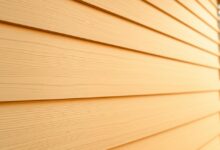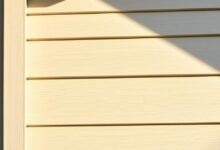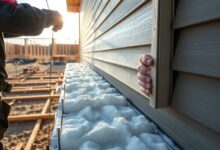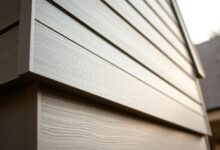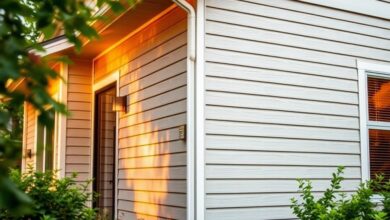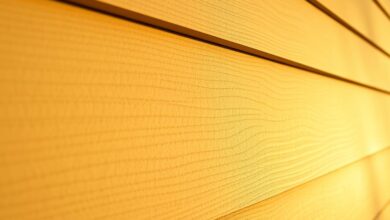Fiber Cement Insulated Siding: Weatherproof Your Home in Style
Homeowners are always searching for ways to make their homes look better and stay warm. Fiber cement insulated siding is a great choice. It’s stylish, strong, and keeps the weather out.
This siding does more than just look good. It also keeps your home safe from bad weather. This means you won’t have to fix things as often. Choosing weatherproofing like this can make your home more comfortable and worth more.
Key Takeaways
- Enhance your home’s exterior with a durable and stylish solution.
- Improve energy efficiency and reduce maintenance needs.
- Increase your property’s value with weatherproofing solutions.
- Enjoy a more comfortable living space with reduced heat loss.
- Protect your home from harsh weather conditions with a robust barrier.
The Benefits of Fiber Cement Insulated Siding
Fiber cement insulated siding is a big win for homeowners. It boosts your home’s energy efficiency and style. This siding solution has many benefits that make it a great choice.
Energy Efficiency and Insulation Properties
This siding improves your home’s energy use. It keeps your home warm in winter and cool in summer. This means lower energy bills and a cozy home.
- Reduced energy consumption
- Lower utility bills
- Enhanced comfort throughout the year
Durability and Weather Resistance
Fiber cement insulated siding is tough and weather-resistant. It can handle heavy rain, strong winds, and extreme temperatures. Its durable nature means it needs little maintenance and lasts for decades.
Aesthetic Appeal and Design Options
This siding also looks great and offers many design options. It comes in various styles, colors, and textures. Homeowners can pick a look that matches their home’s architecture. This makes it easy to get a beautiful and cohesive exterior that increases curb appeal.
Planning Your Siding Project
Before starting your siding project, take a moment to assess your home’s needs. This step will help guide your decisions throughout the project.
Assessing Your Home’s Needs
First, check the condition of your siding. Look for damage, rot, or wear. Also, think about your local climate, as it affects siding performance. Make a list of your findings for later use.
- Check for damaged or rotting siding
- Consider your local climate and weather patterns
- Assess the overall condition of your home’s exterior
Budgeting and Cost Considerations
After assessing your home, set a budget for your siding project. Costs vary based on materials, labor, and home size. Remember, insulated siding can save on energy bills over time.
Key budgeting considerations:
- Material costs
- Labor costs
- Potential energy savings
Choosing the Right Style and Color
With your budget in mind, pick the style and color of your siding. Think about your home’s architecture and the neighborhood’s look. Fiber cement siding offers many styles and colors to choose from.
Take your time to pick a style and color that matches your home and surroundings.
Essential Tools and Materials for Installing Fiber Cement Insulated Siding
Getting ready for fiber cement insulated siding installation is all about the right tools and materials. The right equipment makes the job easier and ensures the siding lasts longer.
Required Tools Checklist
You’ll start with basic tools. A circular saw cuts the panels, a drill makes holes for fasteners, and a hammer taps them into place. A tape measure helps with measurements, and a level keeps panels straight. A utility knife is useful for fine-tuning cuts.
| Tool | Purpose |
|---|---|
| Circular Saw | Cutting fiber cement panels |
| Drill | Making holes for fasteners |
| Hammer | Tapping pieces into place |
Materials Shopping Guide
For the siding, pick fiber cement panels that fit your style and color. You’ll also need fasteners that won’t rust and a moisture barrier. Sealant is good for filling gaps and joints.
Safety Equipment and Precautions
When using power tools and fiber cement, safety comes first. Wear safety glasses, a dust mask, and gloves to protect yourself. Make sure your work area is well-ventilated. Using a dust collection system helps keep dust down.
“Safety isn’t just a precaution, it’s a prerequisite for a successful siding installation project.”
With the right tools, materials, and safety gear, you’re ready to install your fiber cement insulated siding confidently.
Step-by-Step Installation Guide
To get a durable and weather-resistant finish, knowing how to install fiber cement insulated siding is key. This guide will help you through each step, from preparing your home’s exterior to the last touches.
Preparing Your Home’s Exterior
Before you start, your home’s exterior needs to be ready. This means taking off the old siding and checking the walls for damage or weak spots.
Removing Old Siding
Take off the old siding carefully to avoid harming the structure underneath. Wear protective gear, including gloves and safety glasses, to keep yourself safe from debris.
Inspecting and Repairing the Wall Structure
After removing the old siding, check the wall for damage or rot. Fix any problems to make sure your new siding has a solid base.
| Inspection Checklist | Action Required |
|---|---|
| Damaged or rotting wood | Replace affected areas |
| Loose or missing fasteners | Secure or replace fasteners |
| Gaps or cracks in the wall | Seal gaps and cracks |
Installing Moisture Barriers
Applying a moisture barrier is a key step to protect your home from water damage. Make sure the barrier is aligned right and fastened securely.
Measuring and Cutting Fiber Cement Panels
Getting your measurements right is essential for a good installation. Measure your walls carefully and cut the panels to size with the right tools.
Securing Panels to Your Home
Start attaching the panels to your home’s exterior, starting from the bottom and moving up. Make sure each panel is level and well-fastened.
Proper Nailing Techniques
Use the right nailing techniques to avoid damaging the panels. Space nails as the manufacturer suggests.
Sealing Joints and Edges
Seal all joints and edges to keep water out. Use a good sealant and make sure it’s spread evenly.
Finishing Touches and Trim Installation
The last step is to install trim and any finishing touches. Make sure all edges are sealed and the finish is smooth and even.
By following this guide, you can get a professional-looking finish. Enjoy your new fiber cement insulated siding for many years.
Conclusion
Fiber cement insulated siding is a top pick for homeowners wanting to improve their home’s look and energy use. Knowing its benefits and how to install it helps homeowners make smart choices for their siding projects.
Installing this siding right ensures it lasts long and keeps weather out. It also makes homes look good, with many design choices to match any style.
Choosing fiber cement insulated siding means a home improvement project that makes your home look better and saves on energy. It’s a great choice for anyone wanting to upgrade their home’s exterior.
